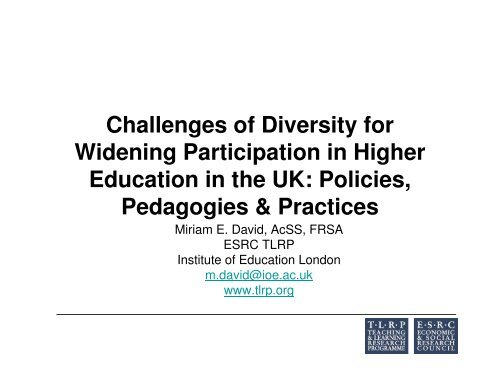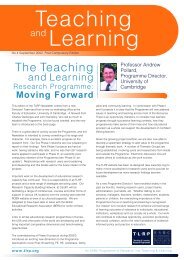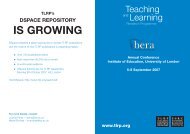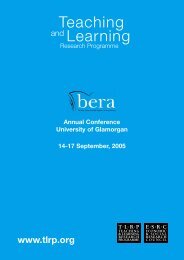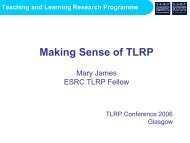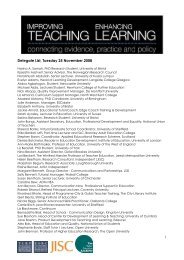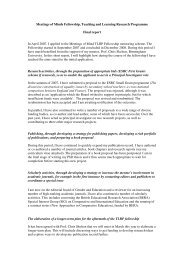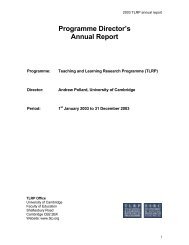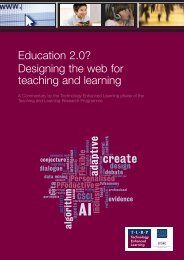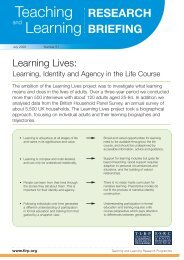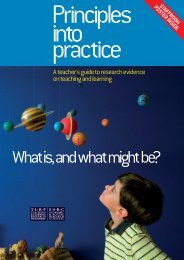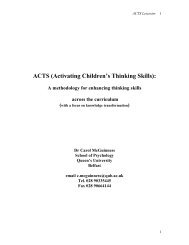Presentation - Teaching and Learning Research Programme
Presentation - Teaching and Learning Research Programme
Presentation - Teaching and Learning Research Programme
You also want an ePaper? Increase the reach of your titles
YUMPU automatically turns print PDFs into web optimized ePapers that Google loves.
Challenges of Diversity for<br />
Widening Participation in Higher<br />
Education in the UK: Policies,<br />
Pedagogies & Practices<br />
Miriam E. David, AcSS, FRSA<br />
ESRC TLRP<br />
Institute of Education London<br />
m.david@ioe.ac.uk<br />
www.tlrp.org
Summary<br />
• Review of diverse research on social change <strong>and</strong> policies on the<br />
expansion or ‘massification’ of higher education in the 21 st century<br />
• Personal perspective as a sociologist <strong>and</strong> educational researcher<br />
<strong>and</strong> through TLRP role on social diversity <strong>and</strong> higher education<br />
• Changing conceptualizations of social diversity <strong>and</strong> inequality or<br />
inequity in research <strong>and</strong> policy e.g widening participation<br />
• Changing policy contexts on HE <strong>and</strong> notions of participation<br />
• Transformations of social/education research on/in higher education<br />
• Review of four themes about higher education <strong>and</strong> diversity<br />
– from context of international/US literature on changing research<br />
perspectives on/in higher education<br />
– TLRP projects on widening participation to, <strong>and</strong> in, Higher Education<br />
(WPinHE) <strong>and</strong> lifelong learning in the UK<br />
• Future challenges of researching learning <strong>and</strong> teaching in higher<br />
education for social diversity
Introduction<br />
• TLRP role is to synthesise research on social diversity, <strong>and</strong> also<br />
work with 12+ projects on higher education, including widening<br />
participation, <strong>and</strong> lifelong learning.<br />
• 7 projects on WP in HE commissioned just over 2 years ago in<br />
context of constantly changing policy debates about HE<br />
• Policies on WP now being revised <strong>and</strong> augmented, eg March 2008<br />
John Denham, Secretary of State for DIUS announced 20 new HE<br />
centres based on FE colleges in towns without universities<br />
• Review for British Journal of Sociology of Education (2007 28 (5)<br />
675-690) on ‘Equity <strong>and</strong> diversity: towards a sociology of higher<br />
education for 21 st century’.<br />
• Now contested <strong>and</strong> diverse research about teaching <strong>and</strong> learning,<br />
pedagogies, policies <strong>and</strong> academic practices
Conceptual considerations<br />
• Troubling concepts of diversity, equity <strong>and</strong> inclusion:<br />
from ethnicity/race to class, gender, sexualities <strong>and</strong><br />
dis/abilities <strong>and</strong> age (young versus mature students)<br />
• Contested meanings of post-compulsory or postsecondary<br />
Higher Education versus Universities<br />
• Changing notions of education, teaching <strong>and</strong> learning<br />
<strong>and</strong> ‘pedagogies’<br />
• Notions of access to or ‘participation’ within higher<br />
education or universities<br />
• Contexts of market economy or ‘academic capitalism’<br />
• Changing Pedagogies <strong>and</strong> Academic Practices,<br />
including personalised learning as a new approach
4 themes within research about<br />
policies on/in higher education<br />
• Equity, equal opportunities, social stratification<br />
<strong>and</strong> role of HE in relation to social mobility;<br />
• Diversity is a changing concept about<br />
ethnicity/race, social class, age <strong>and</strong> gender for<br />
individuals <strong>and</strong> institutions;<br />
• Globalization, marketization <strong>and</strong> higher<br />
education (HE) or ‘academic capitalism’<br />
nationally or internationally;<br />
• Discourses around teaching <strong>and</strong> learning, critical<br />
or feminist pedagogies <strong>and</strong> academic practices.
Globalization <strong>and</strong> social change in<br />
HE: academic capitalism?<br />
• Slaughter <strong>and</strong> Rhoades (2004) on ‘academic capitalism’.<br />
• ‘At the turn of the 21st century the rise of the ‘new’ global knowledge<br />
or information society calls for a fresh account of the relations<br />
between higher education institutions <strong>and</strong> society. Our analysis of<br />
these relations has led us to develop a theory of academic<br />
capitalism which explains the process of college <strong>and</strong> university<br />
integration into the new economy. The theory does not see the<br />
process as inexorable; it could be resisted…nor…<br />
‘corporatized’…sees actors…as using a variety of state resources<br />
to create new circuits of knowledge that link higher educational<br />
institutions to the new economy…it moves beyond thinking of the<br />
student as consumer to considering the institution as marketer.’<br />
(2004 p.1)<br />
• New discourses to specify the shifts <strong>and</strong> changes as: ‘colleges <strong>and</strong><br />
universities shifting from a public good knowledge/learning regime to<br />
an academic capitalist knowledge/learning regime’ (2004 p.7)
Privilege <strong>and</strong> Diversity in the Academy by<br />
Frances Maher <strong>and</strong> Mary Tetreault (2007).<br />
• They also draw on Slaughter <strong>and</strong> Rhoades’ (2004)<br />
concept of ‘academic capitalism’.<br />
• ‘we are both puzzled <strong>and</strong> energized…about how to<br />
explain the wide discrepancies between the warnings<br />
sounded by national publications about the ‘kept<br />
university’ or ‘academic capitalism’ versus the sense of<br />
autonomy <strong>and</strong> scholarly integrity…as for progress of<br />
diversity initiatives…another perspective …show[s] that<br />
the 35 years between the sex discrimination suits of the<br />
1970s <strong>and</strong> today is too short a period of time to<br />
overcome long-entrenched sexism <strong>and</strong> racism of the<br />
academy…It may take the innovators of this generation,<br />
…of faculty <strong>and</strong> administrators to fully institutionalize<br />
diversity.’ (pp 194-5)
Shavit et al 2007 Stratification in Higher<br />
Education: A comparative study<br />
…present a range of different hypotheses about<br />
the relationships between ‘…expansion <strong>and</strong><br />
differentiation’ <strong>and</strong> whether ‘higher education<br />
expansion is primarily a process of diversion<br />
(sic), channeling members of the working class<br />
to lower-status postsecondary opportunities in<br />
order to reserve higher-status opportunities for<br />
the elite (Brint <strong>and</strong> Karabel 1989) or a<br />
….process of inclusion’ (ibid p. 5-6).
More Inclusion Than Diversion: Expansion,<br />
Differentiation, <strong>and</strong> Market Structure in HE<br />
• diversified systems of Israel, Japan, Korea, Sweden,<br />
Taiwan <strong>and</strong> the US; (Arum et al, Introduction pp 1-35)<br />
• binary systems of Great Britain (sic), France, Germany,<br />
The Netherl<strong>and</strong>s, Russia, Switzerl<strong>and</strong>;<br />
• unitary <strong>and</strong> other systems of Australia, The Czech<br />
Republic <strong>and</strong> Italy.<br />
• The key question about educational expansion is<br />
whether it reduces inequality by providing more<br />
opportunities for persons from disadvantaged strata, or<br />
magnifies inequality by exp<strong>and</strong>ing opportunities<br />
disproportionately for those who are already<br />
privileged’(2007, p.1)
Shavit et al 2007 Stratification in Higher<br />
Education: A comparative study<br />
• Conclusions match previous studies of<br />
comparative educational systems.<br />
• But do not include countries in Latin America.<br />
• Exp<strong>and</strong>ing education <strong>and</strong> opportunities may<br />
lead to maintaining broad social inequalities,<br />
despite the changing economic <strong>and</strong> social<br />
structures <strong>and</strong> systems.<br />
• Greater diversification or diversion (to coin<br />
their terms) for both individuals <strong>and</strong> institutions.
Shavit et al 2007 Stratification in Higher<br />
Education: A comparative study<br />
• findings from this project provide evidence of the<br />
relations among institutional expansion,<br />
differentiation <strong>and</strong> privatization, <strong>and</strong> stratification<br />
of individual educational opportunity.’(2007, p.<br />
27).<br />
• They find overall persistent inequality (sic)<br />
(ibid p.29) but that it may have policy<br />
implications about how to transform class<br />
inequalities in an exp<strong>and</strong>ing situation where they<br />
‘reach a more optimistic conclusion’ (ibid p.29).
Shavit et al ‘a note on gender inequality’<br />
(2007, p.25-6).<br />
• ‘although it was not the main focus of our inquiry, we would be remiss if we<br />
did not mention the findings related to variation in gender inequality (my<br />
emphasis) …consistent with other researchers …our findings indicate that<br />
men’s advantages in educational attainment declined dramatically during<br />
the second half of the twentieth century. The erosion of male advantage is<br />
especially pronounced for participation in postsecondary education. In all<br />
countries for which data are available, <strong>and</strong> in both the conditional <strong>and</strong><br />
unconditional models, men’s relative advantage declined …<br />
• In sum, our data show an average widening of the gender gap in higher<br />
education favoring women, <strong>and</strong> indicate that the gap exp<strong>and</strong>ed fastest in<br />
systems where attendance rates exp<strong>and</strong>ed most. While there are<br />
differences across systems in the rate of change, overall there is a fairly<br />
uniform pattern of women’s increasing participation in higher education,<br />
closing the gap, <strong>and</strong> then often coming to outperform men in higher<br />
education enrollment (2007, p 25-7).
The Context of Massification of HE:<br />
Changing UK rates of ‘student participation’<br />
• Expansion of undergraduate student numbers<br />
over last 40 years in UK Higher Education<br />
– from 0.5 million in 1960s to 2 million in 2005-6<br />
• Questions of social class, gender, race,<br />
ethnicity, dis/abilities <strong>and</strong> age (young vs mature)<br />
remain central policy dilemma, now about<br />
diversity<br />
– Women have outnumbered men since 1996/7<br />
• Women are 60% of full-time student population in British<br />
universities (Scottish, Welsh, Irish <strong>and</strong> English differences)<br />
– Men remain the majority in overseas undergraduate<br />
<strong>and</strong> postgraduate enrolments in 2006-7
<strong>Research</strong>ing Diversity <strong>and</strong> WP in<br />
HE: Projects from TLRP (end 2008)<br />
• 7 projects commissioned by ESRC but<br />
funded by Hefce as ‘policy relevant’<br />
• Address ‘evidence’ on themes of<br />
– policy <strong>and</strong> policy change around notions of<br />
HE <strong>and</strong>/or universities<br />
– social diversity variables <strong>and</strong> practices about<br />
‘participation’ in types of education<br />
– types of pedagogy or teaching <strong>and</strong> learning<br />
strategies
<strong>Research</strong>ing Diversity <strong>and</strong> WP in<br />
HE: Projects from TLRP (end 2008)<br />
• Dual systems/regimes of FE <strong>and</strong> HE: Role of<br />
FE in HE <strong>and</strong> vice versa (Parry & Bathmaker)<br />
• Quantitative cohort studies of young people<br />
<strong>and</strong> stages of education (Vignoles et al)<br />
• Degrees of success? Vocational &<br />
Educational Training (VET) (Hayward & Ertl)<br />
• Maths Education as a dem<strong>and</strong>ing subject for<br />
HE student identities (Williams, Black & Davis)
Diverse Access to/in FE-HE<br />
• Professors Gareth Parry of Sheffield University <strong>and</strong> Ann-Marie<br />
Bathmaker of University of West of Engl<strong>and</strong> have studied the impact<br />
of the dual structures of further education (FE) (college) <strong>and</strong> HE on<br />
strategies to widen participation in undergraduate education.<br />
• Their main focus has been on the policies <strong>and</strong> practices of colleges<br />
[of further education] <strong>and</strong> their role in the expansion <strong>and</strong><br />
diversification of higher education.<br />
• They consider both wider changing education policy context <strong>and</strong> the<br />
specifics of institutional difference with the implications for student<br />
experiences of learning.<br />
• They argue about ‘the boundary paradox’ where<br />
– Duality is associated with dependence <strong>and</strong> difficulty or<br />
– Dual regimes have been permissive, with the boundary<br />
permeable <strong>and</strong> workable, leading to integration rather than<br />
elimination of sector regimes <strong>and</strong> territories.
Quantitative Analysis of HE<br />
• Dr Anna Vignoles of the Institute of Education, London<br />
University has undertaken a quantitative cohort analysis<br />
of widening participation in HE. They<br />
– used an innovative linkage of newly available data sets <strong>and</strong><br />
sophisticated modelling techniques to examine determinants of<br />
entry into <strong>and</strong> progress within HE.<br />
– have created a definitive baseline study of full- <strong>and</strong> part-time<br />
undergraduate students, their educational achievements in<br />
school <strong>and</strong> HE, demonstrating complex social class <strong>and</strong><br />
gendered pathways.<br />
• Aspects of their analysis have shown that neither poor<br />
(defined as Free School Meals) nor mature students<br />
perform academically less well than traditional students<br />
(aged 18 plus) in access to HE. Indeed mature students<br />
may get better results at the end of their HE courses.
Degrees of Success?<br />
Vocational & Educational Training<br />
• Drs Geoff Hayward, Michael Hoeschler & Hubert Ertl of<br />
Oxford University investigated the development of<br />
vocational <strong>and</strong> educational training (VET) <strong>and</strong> links with<br />
HE by institution (HEI) <strong>and</strong> subject. They studied<br />
students’ progression routes into, <strong>and</strong> through, HE <strong>and</strong><br />
into the labour market. Analysis of largescale datasets<br />
<strong>and</strong> case studies shows that:<br />
– for students’ institutional choice, GCE A levels remain the major<br />
route into more prestigious HEIs (mainly Russell group pre 92)<br />
– Students with VET backgrounds are more likely, on average, to<br />
start their studies at post-92 HEIs<br />
– Rational choice models do not explain HEI choice well<br />
– Subject choices are highly individualised, lead to different kinds<br />
of HEI, <strong>and</strong> also different subjects, connected with diverse wage<br />
premia in the labour market.
Mathematically Dem<strong>and</strong>ing<br />
Subjects for Higher Education<br />
• Professor Julian Williams, with Laura Black, Pauline Davis, Paul<br />
Hern<strong>and</strong>ez-Martinez, Maria Pampaka & Geoff Wake of Manchester<br />
University, focused on pedagogic cultures in relation to learning<br />
mathematics <strong>and</strong> mathematical identities, given the importance of<br />
mathematics to science, technology, engineering <strong>and</strong> medicine<br />
(STEM) in HE.<br />
• They studied over 1700 students ‘on the cusp’ of participation in<br />
mathematically-dem<strong>and</strong>ing programmes in FE or HE ie students<br />
mainly ‘at risk’ <strong>and</strong> studying for HEI access. Using 40 students:<br />
– They found four distinct ‘repertoires’ that students used to account for<br />
their aspirations for HE with ‘influences’ <strong>and</strong> ‘the role of maths’ <strong>and</strong><br />
parental influences.<br />
– These ‘repertoires’ are strongly associated with socio-cultural<br />
backgrounds, albeit in complex, intersectional ways.<br />
• Diverse students’ (class, ethnicity <strong>and</strong> gender) accounts, life<br />
aspirations <strong>and</strong> mathematical identities, important for underst<strong>and</strong>ing<br />
mathematical literacy.
<strong>Research</strong>ing Diversity <strong>and</strong> WP in<br />
HE: Projects from TLRP (end 2008)<br />
• Networks of intimacy <strong>and</strong> decision-making as an<br />
embedded social practice (Alison Fuller, Sue Heath &<br />
Brenda Johnson at Southampton University)<br />
• Socio-cultural <strong>and</strong> learning experiences of working<br />
class students (Gill Crozier, Sunderl<strong>and</strong> University with<br />
Diane Reay of Cambridge University )<br />
• Social Diversity <strong>and</strong> Difference: academics engaging<br />
diverse students (Chris Hockings at Wolverhampton<br />
University with S<strong>and</strong>ra Cooke of Birmingham <strong>and</strong> Marion<br />
Bowl currently in Auckl<strong>and</strong> New Zeal<strong>and</strong>)
Networks of Intimacy: routes to<br />
participation or non-participation?<br />
• Professors Alison Fuller <strong>and</strong> Sue Heath of Southampton<br />
University have studied choices of participation in HE by<br />
focusing on<br />
– decision-making as an embedded social practice not individual<br />
– the notion of ‘networks of intimacy’ as a key theoretical concept<br />
linked to ‘ambivalence’ as a nuanced concept in relation to<br />
continuity <strong>and</strong> change in family, community <strong>and</strong> the life course.<br />
• They have produced 16 case studies of family decisionmaking<br />
around a key informant qualified to enter HE<br />
(level 3) <strong>and</strong> exploring their choices in relation to work<br />
<strong>and</strong> benefits of HE to subsequent lives in education,<br />
family <strong>and</strong> work.<br />
• Heath (2007: BJSE) looked at GAP years <strong>and</strong> their<br />
relation to gaps in achievement by social class.
Socio-cultural & <strong>Learning</strong> Experiences<br />
of Working Class Students in HE<br />
• Professors Gill Crozier, Sunderl<strong>and</strong> University & Diane Reay, Cambridge<br />
University studied the socio-cultural <strong>and</strong> learning experiences of students in<br />
contrasting HEIs, including one with further education.<br />
• They interviewed 89 (mainly white British <strong>and</strong> female) middle & working<br />
class students (parental occupations <strong>and</strong>/or first generation in their family to<br />
go to HE), followed the progress of 27 working class students, & interviewed<br />
key informants across the 4 diverse HEIs in 3 geographical areas.<br />
• The 4 HEI embody different missions, attracting different types of students<br />
with different learning dispositions, <strong>and</strong> they found that:<br />
– The middle class students have learned dispositions to fit with the<br />
university context, generate ‘habitus’ through further social interactions.<br />
– The working class students’ lives were often fragile <strong>and</strong> subject to<br />
disruption, although they may have been doing well academically.<br />
• They argue in ‘Different Strokes for Different Folks’ that the institutional or<br />
structural differences interweave with the middle class students’ capitals to<br />
perpetuate privilege <strong>and</strong> advantage: ‘classed privilege’, links educational<br />
success to cultural behaviour. Whilst widening participation has opened up<br />
HE for working class students which hitherto they would not have had,<br />
inequalities continue, <strong>and</strong> impact on life chances within <strong>and</strong> across HEIs.
Diversity & Difference in HE:<br />
academic engagement?<br />
• Dr Chris Hockings of Wolverhampton University’s centre for excellence in<br />
teaching <strong>and</strong> learning (CoTL) focused on teaching or pedagogies for social<br />
diversity in different subjects (computing, biology, business, nursing & social<br />
work) in 2 diverse HEI. Marion Bowl, co-director, wrote about Nontraditional<br />
Students in HE (2004) S<strong>and</strong>ra Cooke, co-director, of Birmingham<br />
University worked with non-traditional students conducted the Hodge Hill<br />
study of Young Participation (Hefce, 2007)<br />
• Using the concept of ‘academic engagement’, they explored the conditions<br />
under which students engage with, or disengage from learning, in the<br />
context of student diversity.<br />
• They explored diverse pedagogies for learning, <strong>and</strong> in a case study focused<br />
upon uses of video methods among computing students.<br />
• Over the 2 year course of the study the computing teachers<br />
– Became more aware of their influences on engagement in classrooms<br />
– Experimented with intervention strategies, including problem/enquiry based<br />
learning, collaborative/cooperative groups to ‘personal knowing to socially<br />
identified knowledge’ to develop a climate of trust for inclusive learning<br />
environments.
<strong>Research</strong>ing Students within HE in<br />
TLRP: some other examples<br />
• Disabled Students in HE (Mary Fuller, Sheila Riddell,<br />
Mick Healey et al)<br />
• SOMUL (John Brennan, David Jary, Mike Osborne et al)<br />
• Music Education in HE (Graham Welch, Rosie Burt et al)<br />
• Dai Hounsell <strong>and</strong> Noel Entwistle’s work on enhancing<br />
teaching <strong>and</strong> learning environments in undergraduate<br />
courses (ETL)<br />
• A Values-based Approach to Teacher Education in<br />
Northern Irel<strong>and</strong> (Alan Smith et al)<br />
• <strong>Learning</strong> Lives (Gert Biesta, Phil Hodkinson, Flora<br />
Macleod et al)
Diversities in <strong>Learning</strong> <strong>and</strong> <strong>Teaching</strong>:<br />
Policy & Practice Implications<br />
• TLRP projects focused on ‘equity’ or equal opportunities as social<br />
class rather than other diversities (gender, ethnicities) in relation to<br />
students across subjects/disciplines <strong>and</strong> institutions<br />
• In terms of WP, show that complex questions about individual or<br />
family ‘choices’, linked to class <strong>and</strong> gender, <strong>and</strong> subjects eg VET or<br />
maths, <strong>and</strong> about present, not imagined future careers.<br />
• Some about teaching <strong>and</strong> pedagogies which influences ‘choices’<br />
or pathways through prior experiences of education, eg Hounsell,<br />
Ivanic, Brennan <strong>and</strong> Hockings on engagement.<br />
• Contexts <strong>and</strong> communities are very important in respect of when<br />
<strong>and</strong> how individuals participate, including ‘networks of intimacy’ <strong>and</strong><br />
prior educational experiences of socially just pedagogies, e.g.<br />
feminist or critical pedagogies.
Conclusions: Equity <strong>and</strong> Diversity<br />
in teaching <strong>and</strong> learning in HE<br />
• Rich <strong>and</strong> diverse studies of differing notions of<br />
participation of students, researchers <strong>and</strong>/or academics<br />
• Range over diverse social science methods <strong>and</strong><br />
concepts from social statistics to qualitative/ethnographic<br />
• Diverse research on equity <strong>and</strong> diversity, teaching <strong>and</strong><br />
learning <strong>and</strong> diverse pedagogies<br />
• Social evidence confirms that social stratification <strong>and</strong><br />
inequalities maintained through diversified not inclusive<br />
forms of HE (Shavit, Arum & Gamoran 2007)<br />
• The diverse HEIs created are part of academic<br />
capitalism (Slaughter & Rhoades 2004) in the new<br />
market economy with new teaching/learning regimes
Challenges of Diversity for Critical<br />
Pedagogies in HE in the 21 st century<br />
• Processes have created <strong>and</strong> sustained social diversity across HE,<br />
creating new opportunities for socially just <strong>and</strong> personal pedagogies<br />
as well as maintaining ‘classed privilege’.<br />
• Inequality & Diversity i.e. Age, Class, Gender, Race/Ethnic<br />
inequalities in relation to participation in HE.<br />
• Social divisions <strong>and</strong> inequalities across HEIs linked to a highly<br />
selective professional <strong>and</strong>/or graduate labour market. What are<br />
graduate premia for many students <strong>and</strong> their future employment?<br />
• How can our academic practices for teaching <strong>and</strong> research in the<br />
21 st century develop new forms of academic engagement <strong>and</strong><br />
intellectual love?<br />
• Can we meet the challenge of building upon the creative potential of<br />
critical <strong>and</strong> feminist pedagogies <strong>and</strong> practices for social diversity<br />
<strong>and</strong> social justice?


